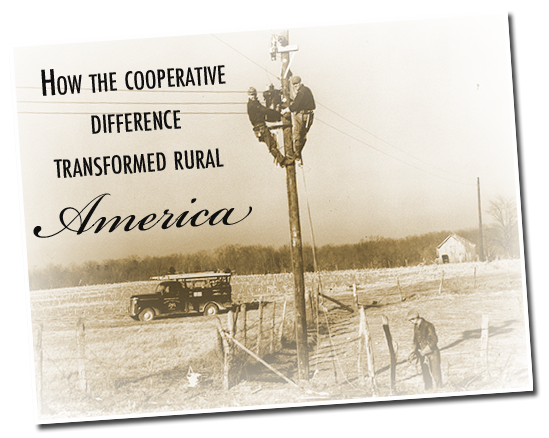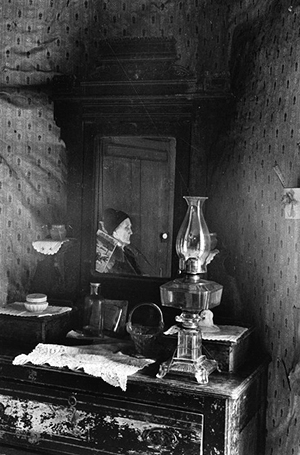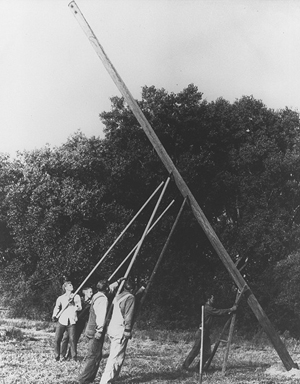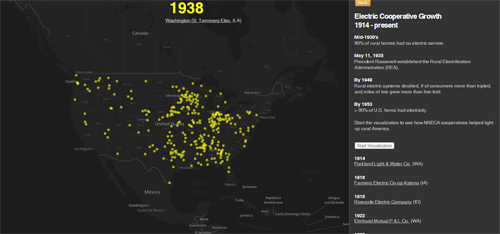Co-op History

Since 1936 electric co-ops have built 2.5 million miles of power lines across rural America – long enough to reach from the earth to the moon five and a half times.
The story of how electric co-ops were built – not by big businesses looking for profit but by ordinary people working together – makes this an American dream we can all be proud of.
Co-op Difference
In the 1930s, 90 percent of Americans living in cities had access to central station electricity service, but only 10 percent of rural Americans could claim the same. Since rural electric service generated little “profit” and required capital expenditures to reach the consumer, investor-owned utilities demanded farmers and their neighbors pay up to $3,000 per mile to build lines to their homesteads, then charged monthly rates as high as $30 – far above what city dwellers paid. This was during a time when per capita income averaged around $1,800 a year.
Before co-ops, in many rural areas, power was not available at any cost. To get around the utilities, enterprising folks deployed “light plants” powered by steam engines and windmills or complicated battery systems to provide themselves with electricity. However, these household generators were not only bulky, noisy, expensive and costly to maintain, but they produced very little electricity – just enough to “light the lights (dimly)” or run a few appliances – and posed a safety risk.
But all of that was about to change. In 1935, President Franklin D. Roosevelt signed an executive order creating the Rural Electrification Administration (REA) – now Rural Utilities Service – with one goal: to provide low-cost loans and engineering support to help electrify the countryside.

“Electricity is a modern necessity of life and ought to be in every village, every home, and every farm in every part of the United States,” announced Roosevelt.
To meet the challenge, farmers and other rural community leaders joined forces to form electric cooperatives. A fee of $5 was collected from each family – making them members and the owners of the co-op – to generate the capital needed to qualify for a loan. As a result, most of the nation’s 900-plus not-for-profit, consumer-owned electric co-ops were formed in the late 1930s and early 1940s.
Within its first two years, the REA helped co-ops invest in 53,000 miles of power lines connecting rural communities. As more people discovered the potential of electricity, business boomed. In 1949 alone, 184,000 miles of electric co-op lines were built, an average of 700 miles constructed every working day. Soon innovations in line building pioneered by co-op engineers and the competitive pressure co-ops placed on investor-owned utilities to serve rural areas slashed the cost of providing electric service in the countryside by 50 percent or more.

Even today, the economics that led to the formation of electric co-ops remain. Nationwide, for every mile of power lines that electric cooperatives build and maintain, they serve an average of seven members and generate $10,565 in revenue. In comparison, profit-driven investor-owned utilities average 35 customers per mile and earn $62,665 in revenue.
Since their creation, electric co-ops have a proven track record of offering stable and affordable electric rates. Data from the U.S. Energy Information Administration (EIA) show that since 2000 electric co-op rates have consistently run lower than the industry average. In 2010, the 75th anniversary of rural electrification, co-ops managed 2.5 million miles – 42 percent – of the nation’s distribution lines.
Economic Impact
Electric co-ops power communities in many ways. Created and owned by the members they serve, co-ops don’t offer profits to investors. Instead, co-ops distribute capital credits to members when revenues exceed operating costs using the margins to maintain a cost-effective reliable electric system. When their boards of trustees determine the cooperatives are financially able, they periodically return those capital credits. Such refunds are based on patronage – how much of a service a member uses.
The average co-op in the nation serves 40,000 members, though a few co-ops in fast-growing areas of the nation reach more than 200,000 members. According to a 2009 study funded by the U.S. Department of Agriculture, electric co-ops employ 130,000 Americans, both directly and indirectly. With revenues topping out at $45 billion, the nation’s electric co-ops have distributed more than $11 billion in value-added income through employee wages and capital credits. Electric cooperatives are economic drivers in their communities, and they’re not alone.
Guiding Principles

Member-owned cooperatives have also been formed to sell produce, provide loans, insurance and more.
So where did the idea for co-ops come from? The cooperative movement traces its roots to a store started by weavers in the town of Rochdale (pronounced Rotch-dale) in northern England in December 1844. The Rochdale model revolved around a set of guidelines drawn up by one of its members, Charles Howarth. When introduced into the United States by the National Grange in 1874, these “Rochdale Principles” fueled a cooperative explosion.
Although stated in many ways, the Rochdale Principles hold that a cooperative must provide:
- Voluntary And Open Membership – Membership in a cooperative is available to all who can reasonably use its services, regardless of race, religion, sex, or economic circumstances.
- Democratic Member Control – Cooperatives are democratically controlled, with each member having one vote regardless of patronage. As a result, control remains in the hands of all customers. Directors are elected from among the membership.
- Members’ Economic Participation – Cooperatives provide services “at cost” and remain not-for-profit regardless of the value of benefits delivered. Any money left over after all expenses are paid – margins – belongs to the members. Each member’s share in the margin is determined by the amount of his or her patronage, or use, of the cooperative’s services. These are the capital credits described above.
- Autonomy And Independence – Cooperatives are self-sustaining, self-help organizations controlled by their members.
- Education, Training, and Information- Keeping members, directors, managers, and employees up to date on issues so they can effectively govern the cooperative. Communication, particularly with young members and opinion leaders, helps generate necessary public support for cooperatives.
- Cooperation Among Cooperatives – Mutual support helps cooperatives improve services, bolster local economies, and deal more effectively with social and community needs.
- Concern For Community – Cooperatives develop communities through programs supported by the membership.
During the past seven decades, electric cooperatives have grown into a nationwide network serving roughly 17.5 million homes, businesses, farms and other establishments, representing more than 42 million people – 12 percent of the U.S. population. Electricity is no longer a dream for rural America; it’s a reality.
This visualization shows the growth of NRECA electric cooperatives in the United States over time.
>>View visualization
Alabama’s cooperative difference
Imagine what rural Alabama must have been like without electricity. Before 1935, electricity was available only to people who lived in or near cities and larger towns. In fact, many people believed that farm families did not want – or even need – electricity.
The Tennessee Valley Authority
The first official action of the federal government pointing the way to the present rural electrification in Alabama came with the passage of the Tennessee Valley Authority (TVA) Act in May 1933. This act, passed with strong help from U.S. Sen. Lister Hill of Alabama, authorized the TVA Board to construct transmission lines to serve “farms and small villages that are not otherwise supplied with electricity at reasonable rates.” TVA also built dams on the Tennessee River that generated large amounts of hydroelectric power. The dams provided flood control, recreation and aided river navigation.
Cooperatives come to Alabama
 The electric cooperative program was officially born in Alabama on March 2, 1936, when Clarke-Washington Electric Membership Corp. in the south Alabama town of Jackson became the first cooperative to incorporate. Shortly thereafter, on Aug. 4, 1936, 350 members of Cullman Electric Cooperative in north Alabama became the first co-op members to receive electricity in the state.
The electric cooperative program was officially born in Alabama on March 2, 1936, when Clarke-Washington Electric Membership Corp. in the south Alabama town of Jackson became the first cooperative to incorporate. Shortly thereafter, on Aug. 4, 1936, 350 members of Cullman Electric Cooperative in north Alabama became the first co-op members to receive electricity in the state.
PowerSouth Energy Cooperative
On June 24, 1941, the Alabama Electric Cooperative (AEC) was organized in Covington County to generate and transmit electricity to rural electric cooperatives in south Alabama. On Jan. 1, 2008, AEC became PowerSouth Energy Cooperative.
Today
Today there are 22 distribution cooperatives in Alabama, in addition to PowerSouth, which is classified as a generation and transmission cooperative. The Tennessee Valley Authority continues to supply wholesale electricity to eight cooperatives in north Alabama, and the Southern Company also supplies power to some cooperatives through a subsidiary called Southern Power.
